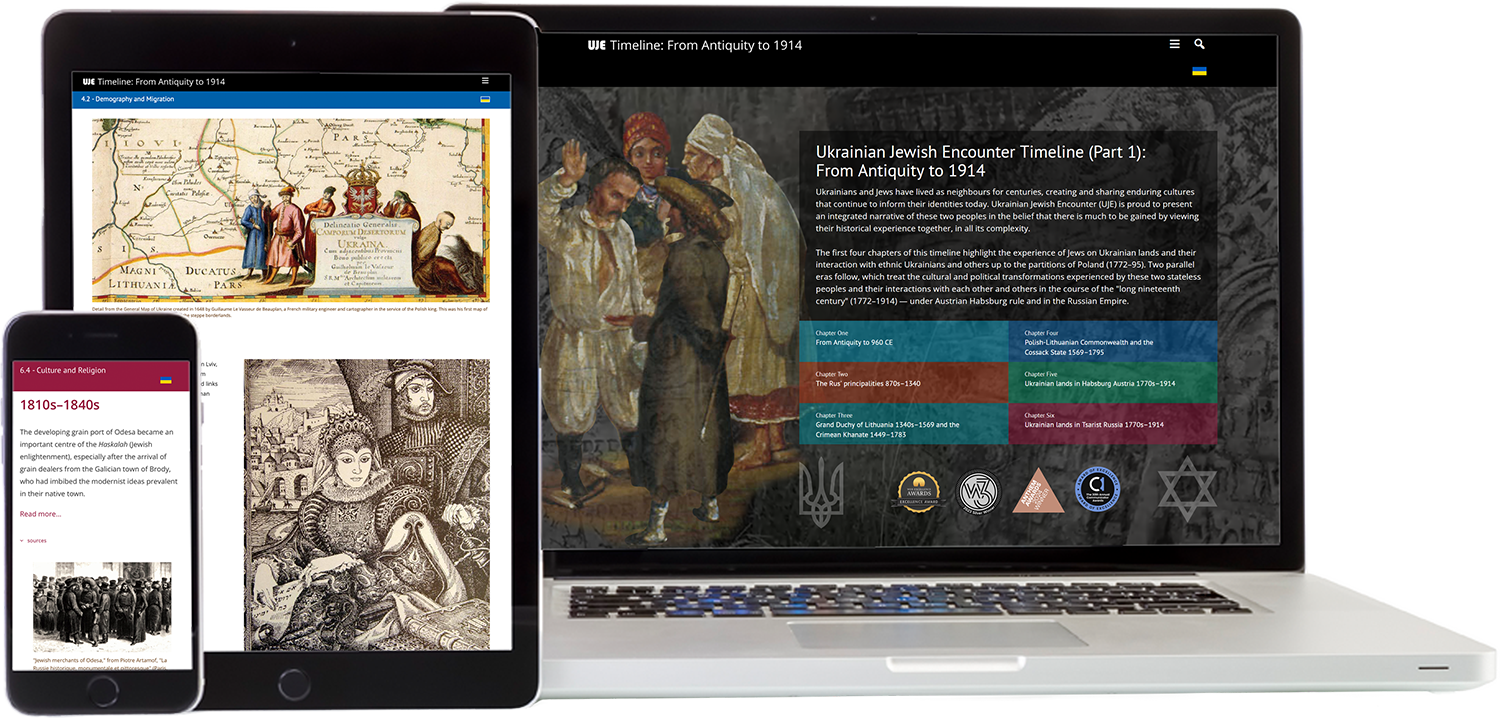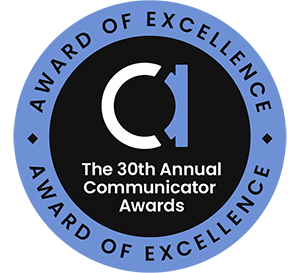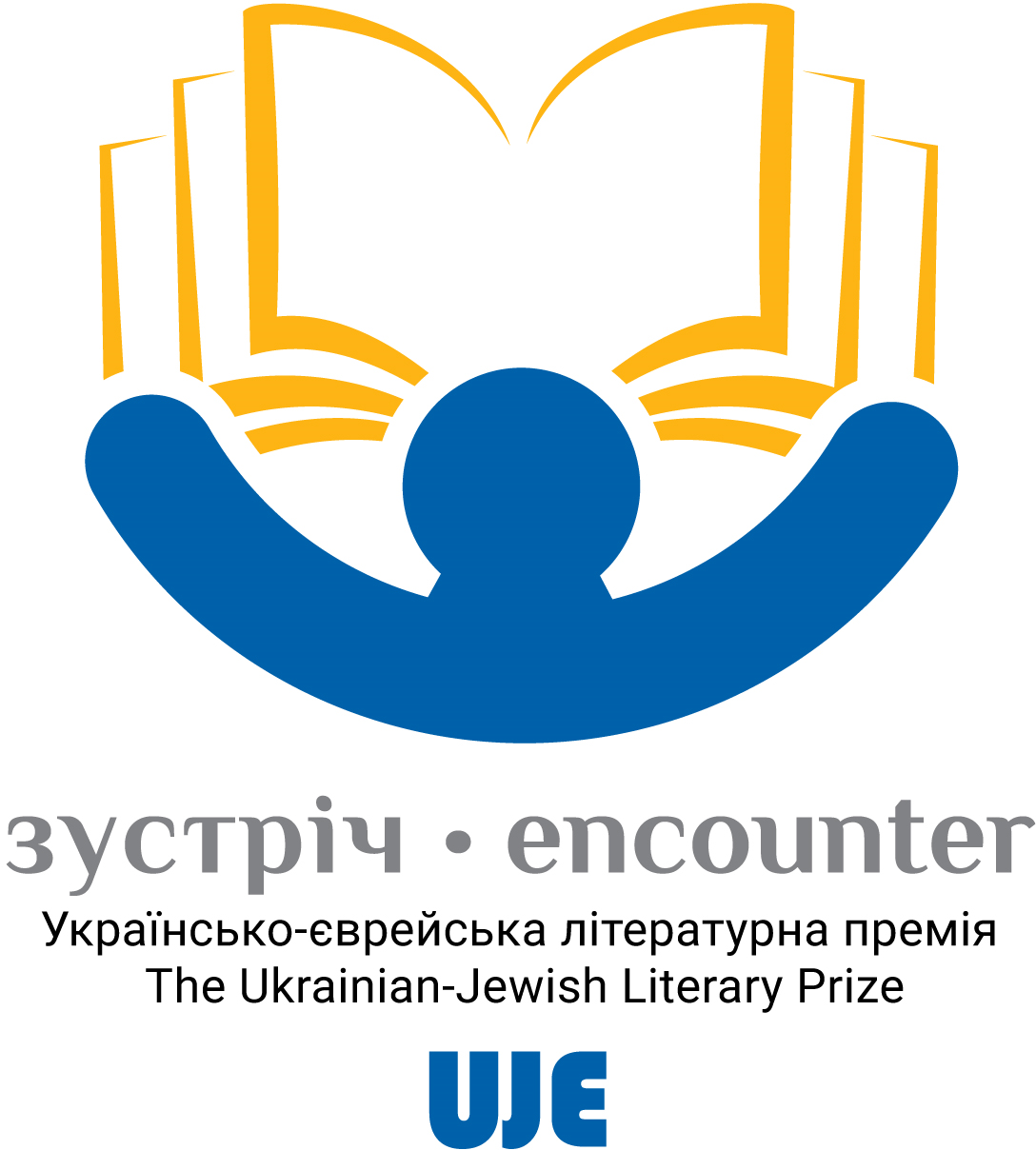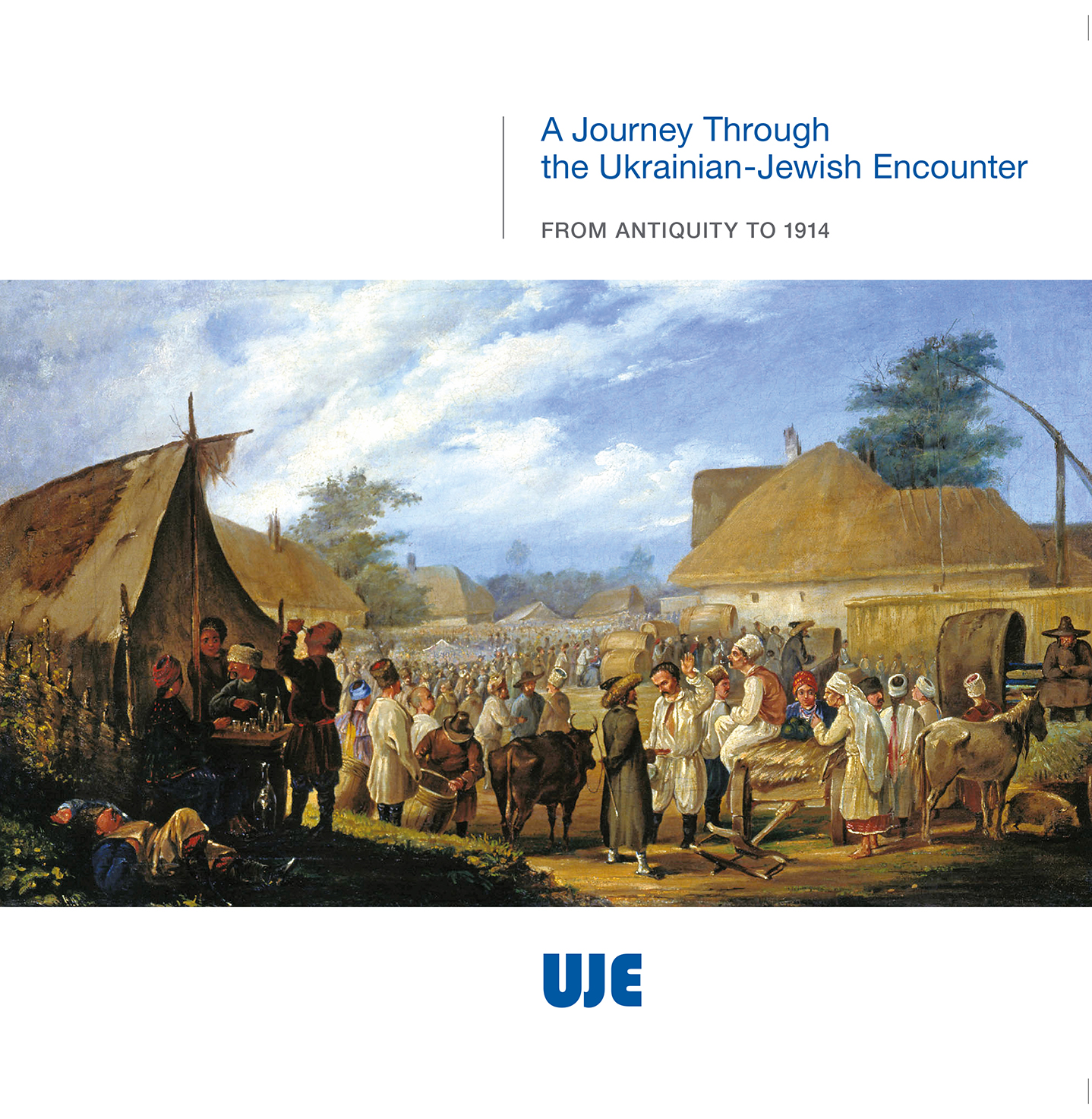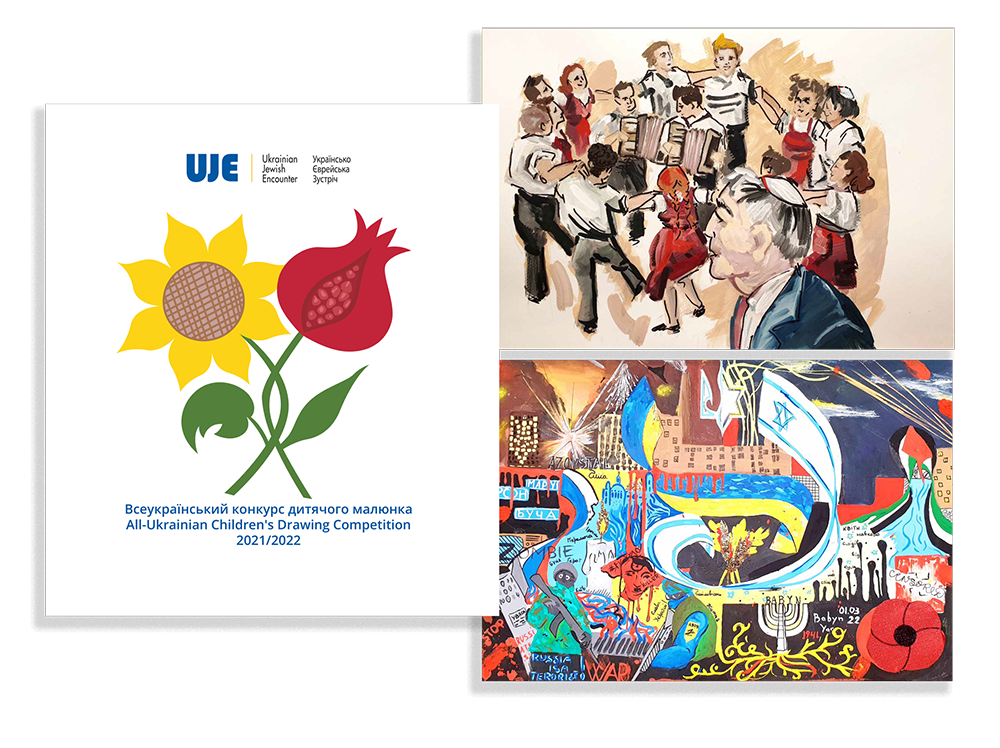Two sides of the same coin
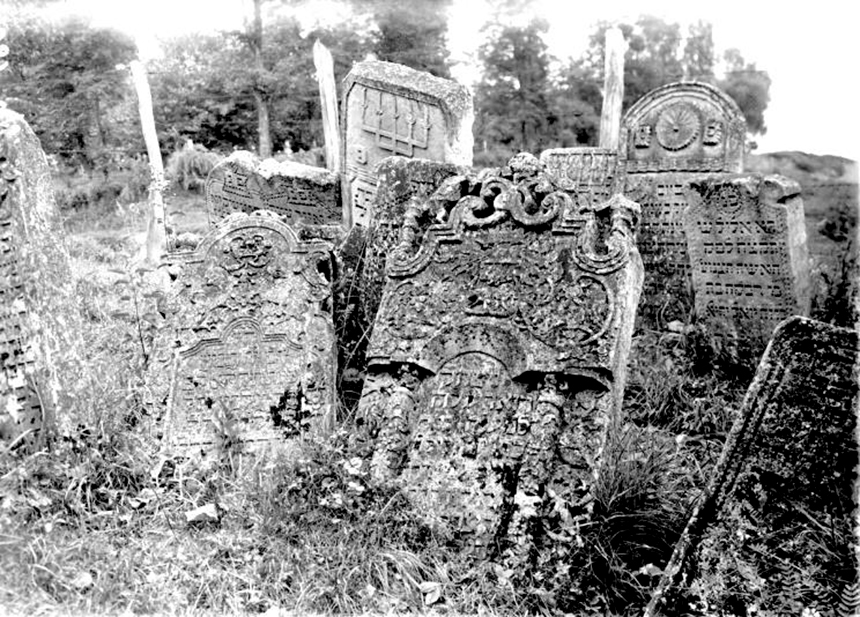
Physical heritage and family history in Jewish cemeteries
by Marla Raucher Osborn,
Gesher Galicia Jewish Heritage Associate
The relationship between Jewish genealogy research and Jewish physical heritage is not widely appreciated, even in the lands of the former Kingdom of Galicia, where there was once so much rich and diverse Jewish culture. For many family historians, the destruction of entire Jewish communities in Galicia during the Holocaust irreparably broke the connection between their ancestors and the towns where they had lived for generations — working, playing, studying, loving.
Yet something important is missing from a deeper understanding of our ancestors when all we have to conjure up their lives are static black-and-white photos and lifeless paper records, displaced from the physical vestiges that remain in their once-thriving homelands.
Well before I knew anything about these existing, though often damaged, physical vestiges, I became my family's genealogist. As a teenager, I enthusiastically created and expanded family trees and collected photos and stories, both about my father's Galician Jewish forebears and my mother's Russian Empire Jewish family that was spread over today's southern Ukraine and northern Moldova. Later, and for almost 25 years now, I have traveled with my husband, Jay Osborn (Gesher Galicia's Digital Maps Manager), to visit the places where our ancestors had lived in towns large and small across Europe, using maps and records together with letters and oral histories to try to get a feel for what their lives may have been like. Over time, I have incorporated an ever-broader range of record types, including school records, business directories, censuses, and cadastral maps, to attempt to breathe life back into those who preceded me, aiming to expand my study beyond individuals and families to include the rich, diverse communities in which they were once members and cultural contributors.
However, nothing prepared me for the shock of encountering the fractured Jewish heritage, obscured but still present, in the small city of Rohatyn in western Ukraine, where my paternal grandmother was born. A new focus on heritage led me to work for two years at Warsaw's Foundation for the Preservation of Jewish Heritage in Poland. I then founded a small NGO in Lviv, Ukraine, called Rohatyn Jewish Heritage, to support a series of preservation projects in my grandmother's city, as described in my article in the March 2018 issue of The Galitzianer. Many of those projects have centered on caring for the cemeteries where Rohatyn Jews buried their dead, and on the recovery and return of the matzevot (headstones) that once marked their graves. I am hardly alone in this effort in the region. As I describe in this article, volunteers, both local and remote, are working across former eastern Galicia to connect the past to the present through material markers of place, time, and people, as well as to document and digitize the results.
The Evolving State of Jewish Cemeteries
Jews had already settled — and established cemeteries — in many places in the southwestern part of the Polish-Lithuanian Commonwealth for several hundred years before the imperial partitions carved the area into the Kingdom of Galicia in the late 18th century. The 19th century saw a four-fold increase in the Jewish population of Galicia to more than 800,000, and a doubling of its percentage to well over 10% of the total population, enabled by the expansion of Jewish communities into many cities, towns, and villages.
The number of Jewish cemeteries existing in the former Galicia on the eve of the German invasion of Poland in September 1939 is not known with precision, but certainly figures in the hundreds. In research conducted for my Fulbright cemetery preservation project (jewishheritageguide.net/en) five years ago, using data from the ESJF European Jewish Cemeteries Initiative and other sources, I personally visited 244 Jewish cemetery sites in eastern Galicia alone. In the current Polish voivodeships that span former western Galicia, ESJF counts 157 Jewish cemeteries, and a recently published report by the National Institute of Cultural Heritage (NID) in Poland counts 159. Thus, collectively, some 400 known Jewish cemeteries have been recorded within the borders of the former Galicia, and there may be other Jewish burial grounds that have not yet been located.
Each of these cemeteries would have been filled with grave markers identifying the deceased and perhaps including brief information about their vital dates, their parentage, and some personal characteristics. Early wooden grave markers did not survive time and the elements, but the stone markers of the wealthy were more durable, as were the markers for many burials from at least the 19th century onward.
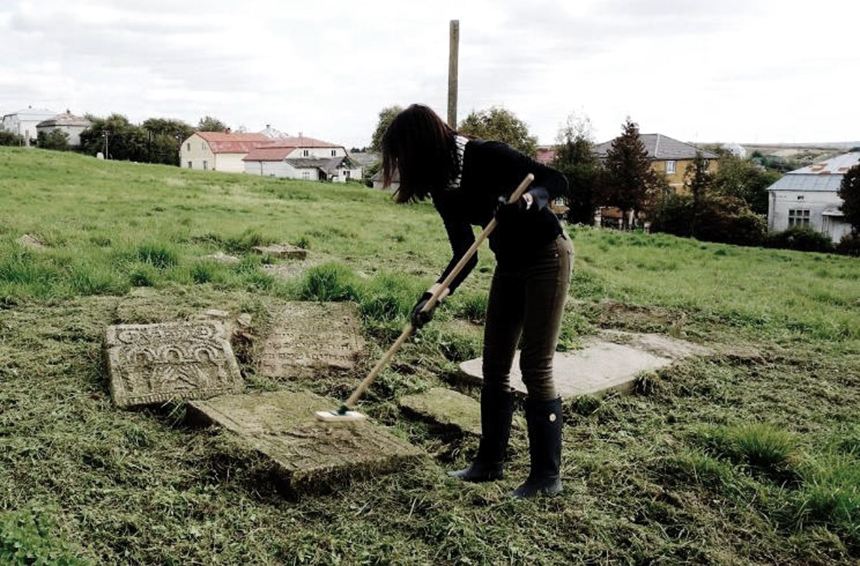
However, there are a handful of datable tombstones from the 16th century that do remain in the former Galicia, in Busk and Buchach (Buczacz in Polish), for example. Such stones enable us to study the stylistic changes over the centuries in inscription formats and content, symbolic images, and ornamental architectural elements. These features are described in an excellent article on Jewish tombstones by Marcin Wodziński in the online YIVO Encyclopedia of Jews in Eastern Europe (encyclopedia.yivo.org/article/1709).
In Galicia, Jewish funerary art not only progressed, but it blossomed. In his book Carved Memories (Rizzoli International Publications, 2000), David Goberman writes:
Carved tombstones are one of the most notable expressions of traditional Jewish art. This form of artistic creativity ... attained a particularly high level of development in the Pale of Czarist Russia and in Galicia. The gravestones of Ukraine and Moldova ... are especially noteworthy for their decorative quality and inventive figurative design.
Importantly, the imaginative art and lettering of these stones conveyed expressive final records of individuals and, taken collectively, of entire communities across generations.
The Holocaust destroyed not only those communities, but also, intentionally, their physical (material) culture. The devastation of Jewish graves, headstones, and entire cemeteries began with isolated antisemitic acts by Wehrmacht soldiers and bystanders, but over time, the wholesale repurposing of Jewish burial sites became a matter of Nazi policy and administrative plans in the German-occupied territories of western Galicia after 1939 and eastern Galicia after 1941. Not only was cemetery land transferred to the occupying authorities for resale, but grave markers were inventoried, extracted, and often broken to be used as construction materials in, among other things, roads, building foundations, walkways, and steps. The infamous 1943 Katzmann report on the "Solution of the Jewish Question in the District of Galicia" includes a chilling photo of standing headstones with the caption "2000 cubic meters of building materials gained from a Jewish cemetery in Lemberg."
Painfully, the war's end did not halt the destruction of Jewish cemeteries. The Wehrmacht's retreat from the region left few living Galician Jews in its wake, and most of those emigrated from their hometowns within the next several years. As a result, the damaged cemeteries had almost no Jewish caretakers and no community resources for repair and rebuilding. In his new book, The Destruction of Jewish Cemeteries in Poland (Academic Studies Press, 2024), Krzysztof Bielawski also documents official Polish state acts, as well as unofficial but widespread practical actions by local governments and individuals, that contributed to the further erasure and loss of Jewish cemeteries in western Galicia.
Eastern Galicia, annexed into the Ukrainian Soviet Socialist Republic, was more directly subject to Soviet indifference — or worse, sanctioned hostility — to religious traditions and prior property ownership. The removal of Jewish headstones from cemeteries continued, and in the decades of Soviet rule that followed, many cemeteries, including some Christian ones, were overbuilt with public structures, such as schools and apartment buildings. Jewish headstones were also commonly used in the foundations of Soviet farm cooperatives, with many still visible today.
Returning to Mourn and Reconnect
The dissolution of the Soviet Union in 1991 enabled ordinary travel from the West to Poland and Ukraine. Early visitors to the relics of once-vibrant Jewish communities must have been shocked at what they found — and couldn't find.
Despite the challenges, many Holocaust survivors and descendants of Jewish families who had emigrated before World War I and World War II did return to commemorate those who had lived and died in the former Galicia. Some went to pray at the graves of their ancestors, even if those graves could not be found; others went to memorialize entire communities. Some returnees attempted to gather and protect the shattered fragments of prewar headstones and to erect memorials to those lost in the genocide. This began on a very small and individual scale before 1991, and later, it often happened as part of survivor and landsmanshaft groups. This practice has accelerated in the past decade, though it remains small, and Russia's full-scale invasion of Ukraine in early 2022 has necessarily created travel and safety issues, resulting in a noticeable drop-off of foreign visitors and new memorial projects.
Twenty-five years ago, in the small city of Rohatyn in western Ukraine, where my NGO conducts its heritage work, survivors and descendants worked with the local administration and religious leaders to fence the two former Jewish cemeteries and erect memorial monuments to the lost community. A decade before I first visited, a handful of these foreign visitors also worked with a Rohatyn resident to gather a few dozen displaced Jewish headstone fragments from around the city and transport them to the cemeteries. I initiated a much larger recovery project only after those survivors and prewar emigrants had passed on. Until about the turn of the 21st century, the primary focus of these reconnections was to memorialize the dead, especially those lost in the Holocaust.
Documenting for Memory and Research
Interest in both Jewish genealogy and heritage preservation has spurred growing activity to locate and record information about Jewish cemeteries and headstones everywhere, especially in the former Galicia. Often, these two purposes function independently, but increasingly, there is greater interest and cooperation between activists in genealogy and heritage organizations to document the surviving physical markers of individuals and communities, as a kind of archive in stone. Some of the organizations that have been involved in this work are described below.
In addition to erecting monuments at a small number of Jewish cemeteries and Holocaust sites in Poland and Ukraine, the United States Commission for the Preservation of America's Heritage Abroad sponsored and managed broad surveys of Jewish heritage, including cemeteries and wartime mass graves. The survey in Poland began in 1991, with a revised report published in 1995; the survey in Ukraine began in 1994, with a final report published in 2005. The surveys engaged more than a dozen local experts and volunteers to locate and document sites, and the reports include important historical essays specific to the regions covered. The data from the surveys is now managed online by IAJGS as part of the International Jewish Cemetery Project. Although groundbreaking, the commission's surveys located only a fraction of the historical cemeteries in the former Galicia.
Mentioned previously in this article are two other organizations doing this type of work: the ESJF European Jewish Cemeteries Initiative and the Polish NID. ESJF ambitiously surveyed and mapped Jewish cemeteries in Poland, Ukraine, and other countries between 2019 and 2020 to create a valuable and comprehensive database of locations, boundaries, and physical conditions, accessible to all on the organization's website. There are also brief histories of prewar Jewish communities and photographs of each site from survey visits. The Polish NID conducted archive and map research in 2017 and fieldwork in 2018–2019 in former western Galicia, confirming ESJF data and locating only two additional cemeteries in its report published in 2024.
My research conducted between 2019 and 2021 in the three oblasts of Ukraine that cover former eastern Galicia (Lviv, Ternopil, and Ivano-Frankivsk) also confirms ESJF data. I documented fewer than a dozen additional cemeteries, all of which were surveyed by ESJF by 2022. At this point, I believe that the total number of Jewish cemeteries identified in the former Galicia is unlikely to change much, if at all.
While the surveys mentioned above identify Jewish cemeteries, they do not include detailed study and documentation of individual graves and markers, which is of primary interest to Jewish genealogists. Fortunately, there are other organizations that record and database Jewish headstones through photographs and epitaph transcriptions and translations. This work continues to grow and improve.
The JewishGen Online Worldwide Burial Registry, known as JOWBR, is by far the largest searchable database of genealogical data on Jewish headstones, with currently more than six million records from over 11,000 cemeteries worldwide. JOWBR is the logical entry point for name-based searches, especially when only the burial region is known. Although its coverage of cemeteries in the former Galicia is still thin (around 120 of the roughly 400 cemeteries as of the most recent update), JOWBR encourages crowd-sourced data submissions, and therefore, I am hopeful that this resource will continue to grow over time. [Editor's note: See Nolan Altman, "A Tutorial on Cemetery Research," The Galitzianer, December 2022, 11.]
In Poland, the nonprofit Foundation for Documentation of Jewish Cemeteries (FDJC; cemetery.jewsh.org.pl/lang_en/) employs a small team of skilled researchers to carefully transcribe data read directly from headstones, a labor-intensive process that ensures accuracy. In addition, FDJC records reference images for every headstone in each cemetery included in its searchable database, which is also accessible through the Jewish Records Indexing-Poland (JRI-Poland) site because of a partnership between the two organizations. Although FDJC's primary focus has been on Warsaw and the Masovian Voivodeship, by the end of 2024, it had also documented 13 western Galician cemeteries (10 of those overlap data with JOWBR).
Since 2009, in the former Galician part of Ukraine, the Israeli nonprofit Jewish Galicia and Bukovina (JGB) has sent academic fieldwork teams, staffed by university professors and students, to work with knowledgeable local volunteers to document the most substantial Jewish cemeteries of the region for its searchable online database (jgaliciabukovina.net/132/article/tombstones). By the end of 2024, JGB had fully documented 18 eastern Galician Jewish cemeteries (16 of these are also in JOWBR) and is now focusing on the former Bukovina. A key feature of JGB's data presentation is the inclusion of full Hebrew epitaph transcriptions, giving researchers the opportunity to consider alternate translations into their preferred language. However, the Hebrew words from the epitaphs are not searchable on the database.
Independent initiatives, usually for individual towns, have also produced data that can sometimes be accessed online, via KehilaLinks pages on the JewishGen website, for instance. Another example was a special research project from several years ago that produced and published in searchable format in the All Galicia Database more than 6,000 records, including genealogically significant names and dates in both Hebrew and English, from the new Jewish cemetery in Brody, as well as GPS locations and high-resolution images.
The Special Case of "Erased" Cemeteries
The dark decline of Jewish cemeteries in Galicia during and after World War II, as summarized in the beginning of this article, creates ongoing risks of loss to both heritage and genealogy resources in the region. This is an unrelenting threat — without action, the losses already accumulated will grow. Jewish cemeteries that were "erased," meaning completely stripped of their headstones, walls, and other visible territorial markers, remain at risk of being repurposed as public or private land, especially in eastern Galicia, where the collapse of the Soviet Union left records and rules of property boundaries and ownership in shambles. Even cemeteries that were only partially destroyed continue to be targets for illicit plundering.
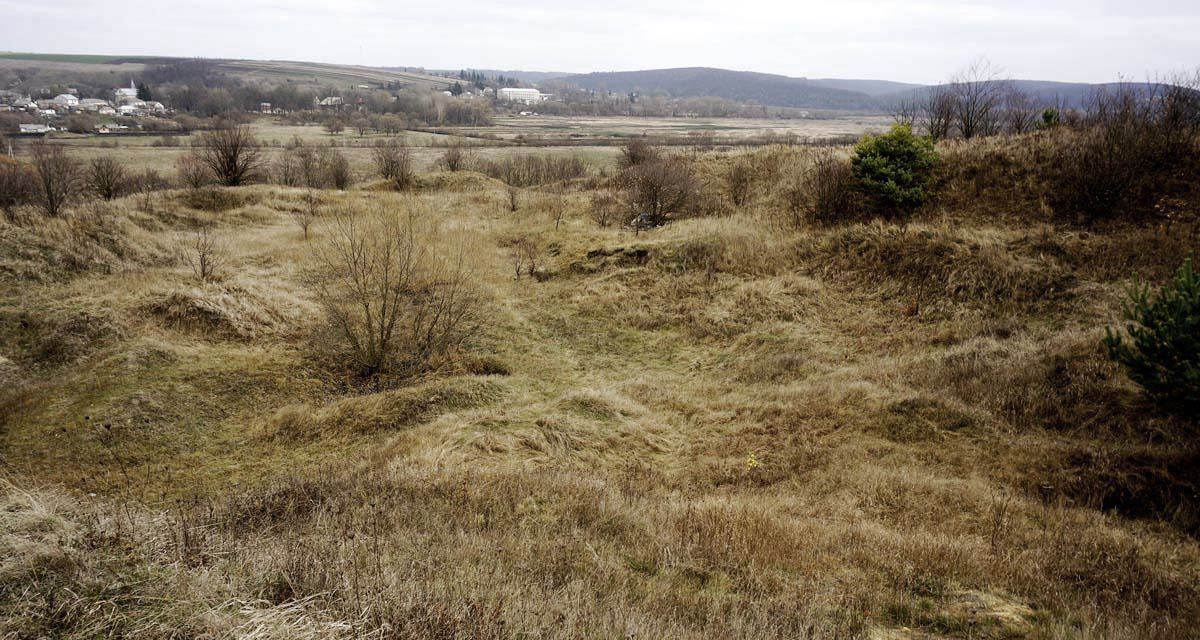
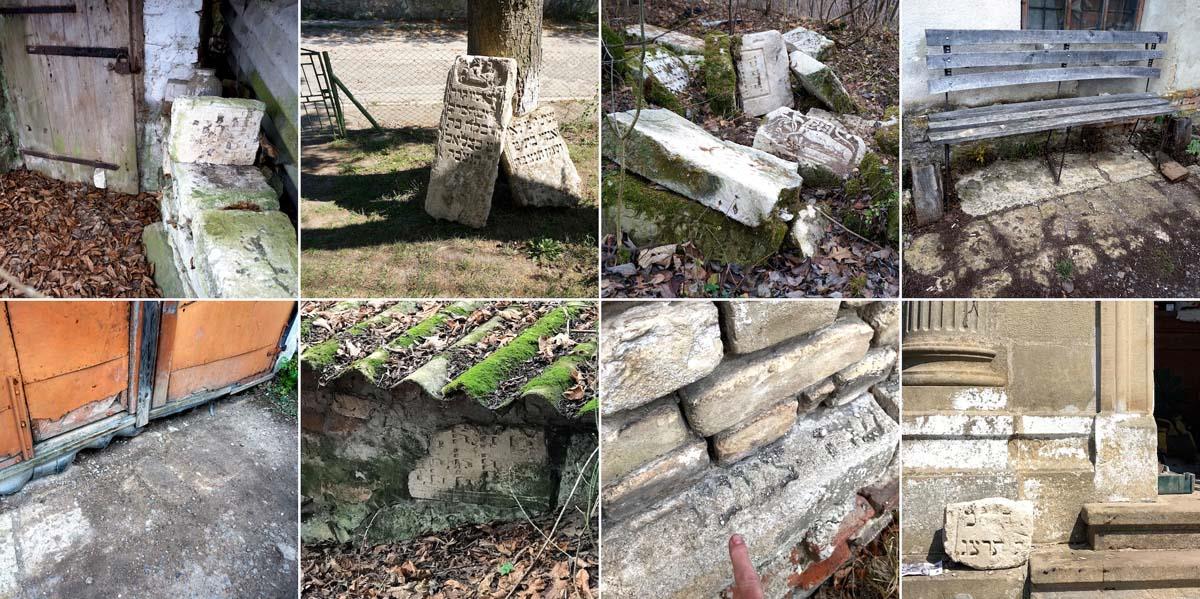
The erasure of Jewish cemeteries explains why so many of them have not been documented in genealogical databases. The survey conducted by NID in historical western Galicia found the following: fewer than 20% of the cemeteries were relatively well-preserved; more than two-thirds were labeled "degraded" (suffering some or significant loss of headstones), a third of which were completely erased; and 10% were overbuilt and lost. In historical eastern Galicia, ESJF survey data reveals that nearly half of all Jewish cemeteries are what they call "demolished," meaning either erased or overbuilt. These cold statistics confirm the shock and dismay that visitors to the region experience when they make these sad discoveries on their own.
However, for a significant number of looted and erased Jewish cemeteries, the stolen headstones were moved and repurposed — that is, damaged but not destroyed. Gradually, as roads are torn apart for upgrades and utility work, as buildings and bridges are renovated or demolished for renewal, and as river levels drop in dry years and ordinary forces of erosion proceed, Jewish headstones reappear — sometimes in unlikely places. Increasingly in Poland and Ukraine and in other countries that suffered during the Holocaust, there are news stories about whole streets or public squares found to have fortification layers made of stolen Jewish headstones. Far more common are the untold stories of individual stones left by roads and waterways after smaller-scale construction work. Usually, the workers recognize the historical crime and want to remove the headstones, but don't know where to take them since there are no Jews in town to ask, and few knowledgeable non-Jews to give guidance.
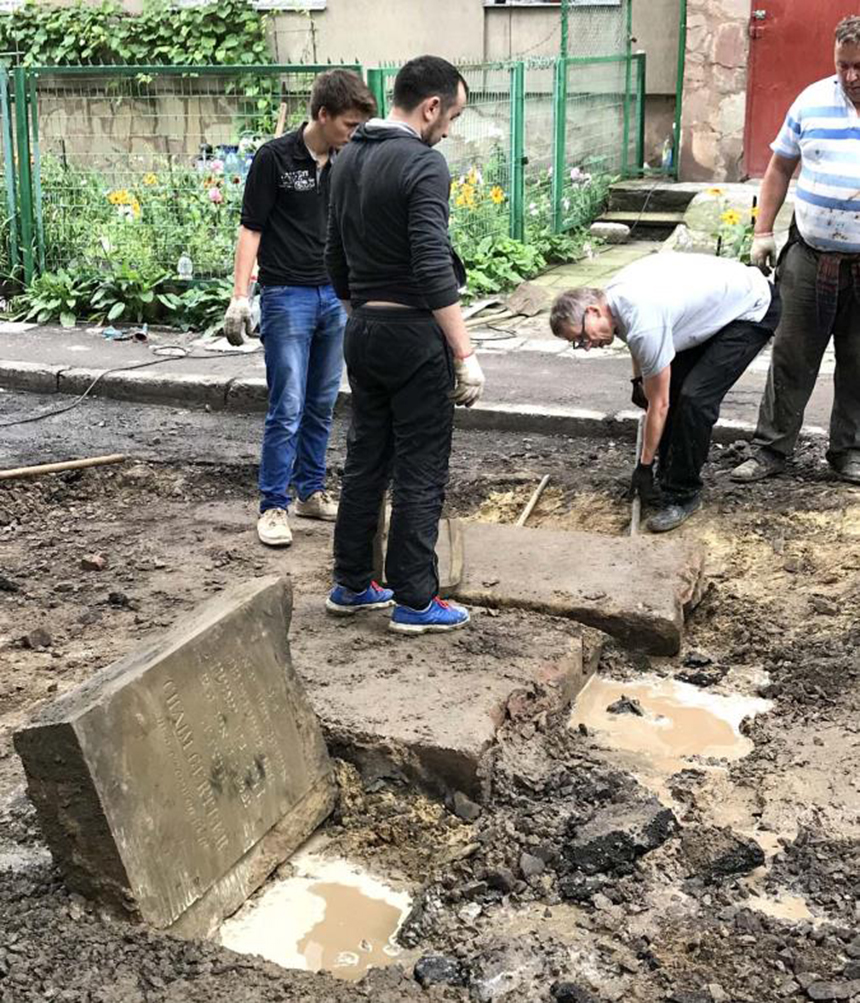
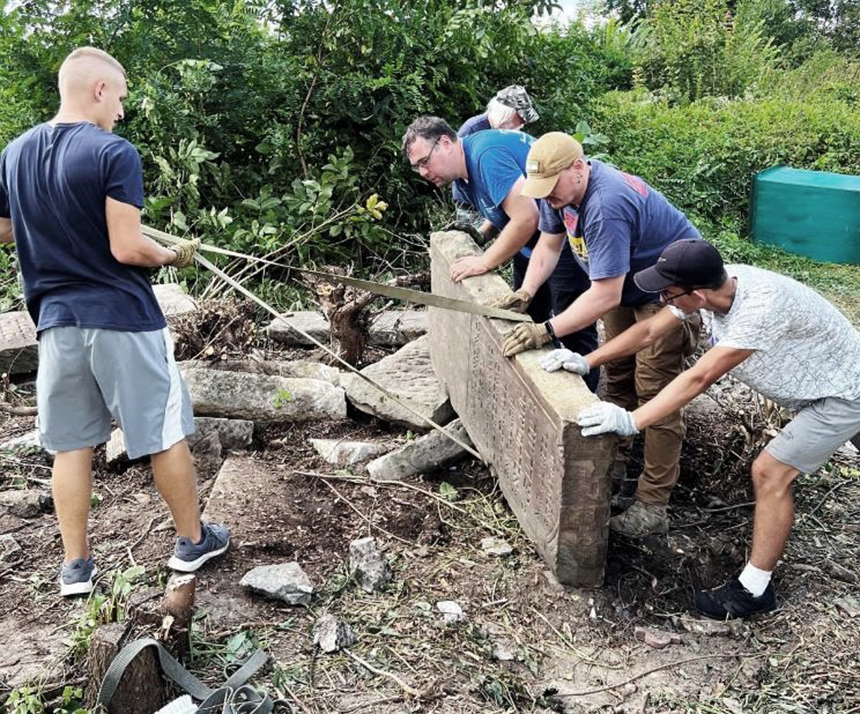
Two prior articles in this journal describe such situations, as well as the efforts to recover and preserve the displaced Jewish headstones. In the March 2023 issue, Arthur Kurzweil discusses a volunteer project to extract more than 200 headstone fragments from the walkway of a house used by German authorities during the wartime occupation of Dobromyl in western Ukraine. He also recounts the story of the construction of a memorial wall from the fragments in that town's erased Jewish cemetery, allowing many of the stones to be read again. In the June 2024 issue, Scott Genzer describes work to extract dozens of headstones from the Wisłoka River in Mielec, Poland, and a project years later to recover hundreds of fragments from the town square. Importantly, the epitaphs of the recovered stones were translated into English and published with images in book form for genealogical and historical research.
Recently, a new initiative has been launched that aims to promote the recovery of displaced Jewish headstones in western Ukraine. It provides documentation of the stones' images and epitaphs online through a new database called Jewish Stones UA, which is searchable in Hebrew, Ukrainian, and English. The project emphasizes recovered headstones to fill in the gaps in the larger and better-known database sites. It also aims to spur new recovery projects through local and cross-border partnerships, making the data useful not only to Jewish genealogists, but also to local Ukrainian-speaking people in the towns where cemeteries are often the only surviving Jewish heritage.
The project is overseen by Sasha Nazar, a Lviv-based Jewish heritage activist and director of the Sholem Aleichem Jewish Cultural Society of Lviv and the Lviv Volunteer Center, an arm of Lviv's Hesed Arieh local Jewish charity organization. Nazar has organized multiple headstone recovery actions in Lviv, was the driving force behind the initiative described by Kurzweil in Dobromyl, and is involved in an ongoing project in Sokal, as well as others elsewhere.
Jewish Stones UA includes data from recovered headstones in Dobromyl, Lviv, and Sokal. The website also fully documents the new Jewish cemetery in Zbarazh, thanks in large part to local Ukrainian researcher Tetiana Fedoriv. [Editor's note: See page 13 of this issue of the journal for an article by Fedoriv on her work in the Zbarazh Jewish cemetery.] In addition, efforts will be proceeding through 2026 to capture the more than 500 headstone fragments recovered by us and others in Rohatyn.
To date, most of the photographing, transcribing, and translating of the recovered headstones for Jewish Stones UA have been provided by volunteers working alongside Nazar, with the website and technical costs funded by donors in Germany and the US and by my NGO, Rohatyn Jewish Heritage. Images and genealogy data for the stones in Dobromyl have already been submitted to JOWBR, and we also hope to share our data with other well-known databases.
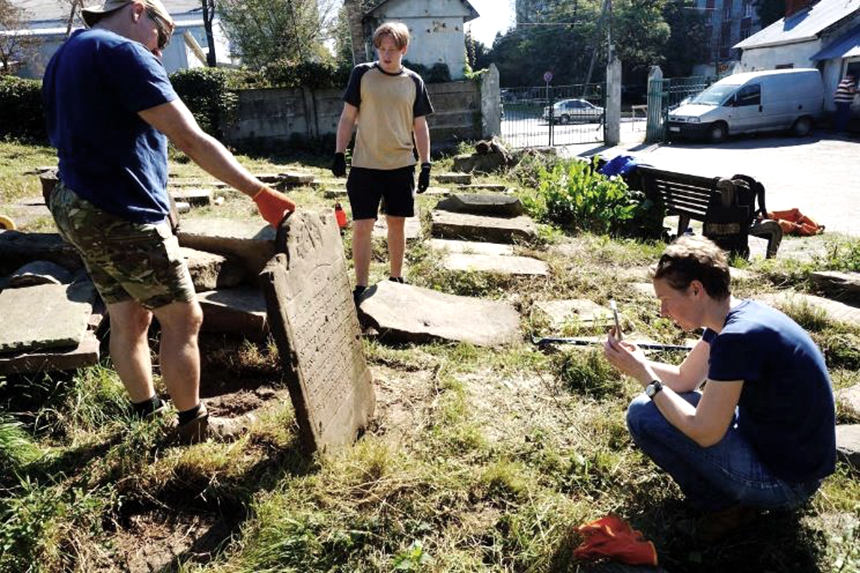

Cooperation Between Communities
Various interconnected actions by people in many different roles are necessary to preserve the heritage of Jewish cemeteries in the region of historical Galicia and to document the genealogical resources they contain. Often, local people in both Poland and Ukraine recognize Jewish cemeteries in their towns as shared heritage between Jewish communities abroad and their own civil communities.
Partnerships, both formal and informal, can create the best circumstances for successful preservation, including long-term care and protection, and new documentation projects as well. As I can attest from our more than a dozen years working in Rohatyn, municipal authorities and cemetery neighbors, as well as local historians, teachers, and librarians, can become key allies for Jewish descendants abroad who wish to reconnect with their ancestral homes. We see this phenomenon in new and ongoing projects in Poland too.
In their articles, both Kurzweil and Genzer highlight how local people partnered with Jews from abroad to recover headstones, care for cemeteries, and keep memory alive through signage, commemorative events, and publications. Nazar's headstone recovery projects always engage both Jewish and non-Jewish Ukrainians and foreigners. The related documentation effort is often a many-handed project from the start as well.
The use of cooperative partnerships in memory preservation is also exemplified in the work of Vitalii Kamozin of the United Jewish Community of Ukraine (UJCU). For several years, Kamozin has worked with regional activists like Nazar, local Jewish communities (where they still exist today), city administrations, and in some cases, descendant families from abroad to successfully place inormation markers at dozens of damaged or erased Jewish cemeteries in eastern Galicia and at well over a hundred sites across all of Ukraine, despite the Russian war.
These markers raise awareness of the historical and ongoing relevance of the sites for both neighbors and foreign visitors, which is especially important when those sites are only empty spaces. In many documented instances, including in Rohatyn and in the village of Skelivka (Felsztyn in Polish) near Sambir, these newly marked sites become a gathering point for the return of recovered headstones, some anonymously by local residents.
In my view, the JewishGen special interest group (SIG) for nearby Bessarabia can serve as a great model of cooperation in cemetery documentation and preservation for Galitzianers. As a community of family researchers (a descendants' group), members of this SIG have worked together and with on-the-ground contractors and volunteers to document headstones. The headstones in almost three-quarters of their more than 80 known cemeteries have been completely recorded, and most of this information has already been submitted to JOWBR. The SIG is also beginning cemetery clearing and restoration efforts.
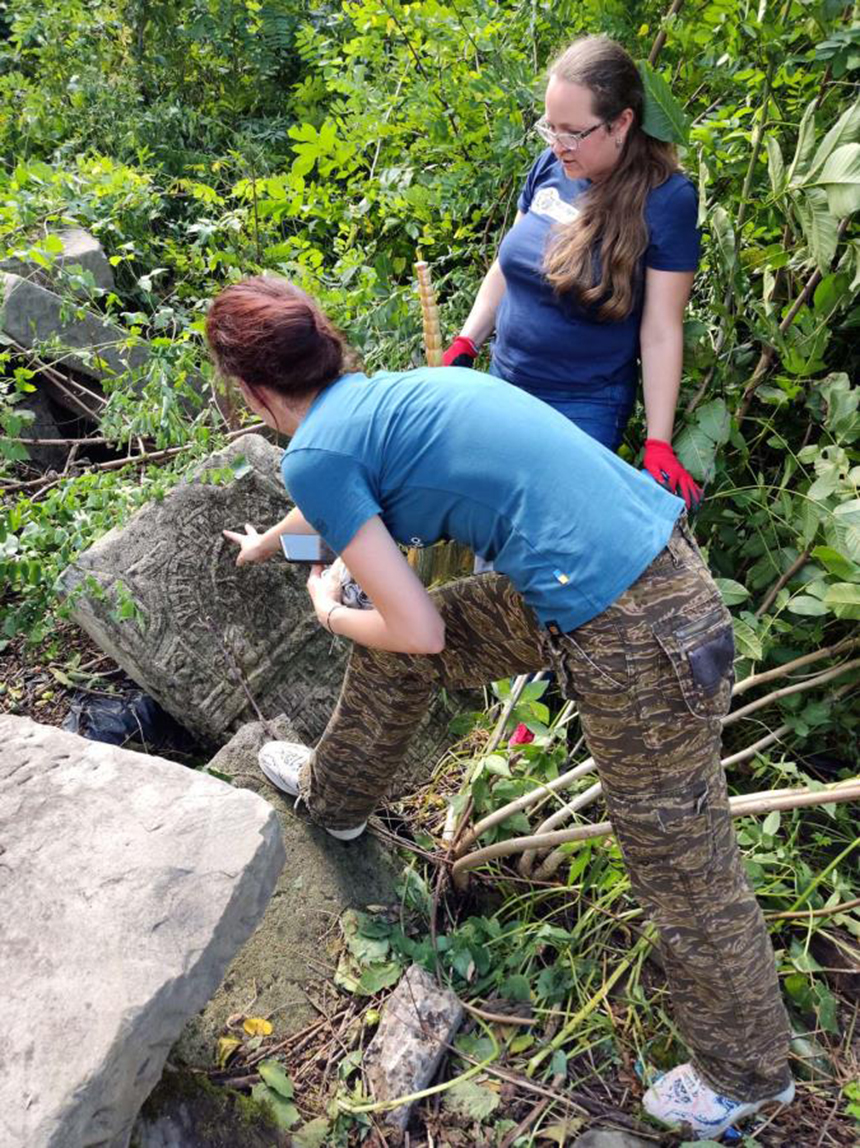
Summing Up
According to Jewish tradition, a cemetery is a holy place, more sacred even than a synagogue. For Jews, the care of cemeteries is an essential religious and social responsibility. The Talmudic saying "Jewish gravestones are fairer than royal palaces" reflects the care that should be given to Jewish graves and cemeteries.
In normal circumstances, the entire Jewish community willingly shares in the protection, repair, and maintenance of cemeteries. The Holocaust broke communities, making cemetery care more difficult. However, resolute individuals and organizations can continue to demonstrate that by building bridges with current communities, we can work together to recover, preserve, and document our shared history.
Editor's Note: Unless otherwise identified in the captions, the photos in this article were provided by Rohatyn Jewish Heritage.
This article originally appeared in the March 2025 issue of The Galitzianer. Permission to reprint the article has been granted by Gesher Galicia. The Galitzianer is a membership benefit of Gesher Galicia. For more information, visit www.geshergalicia.org.







